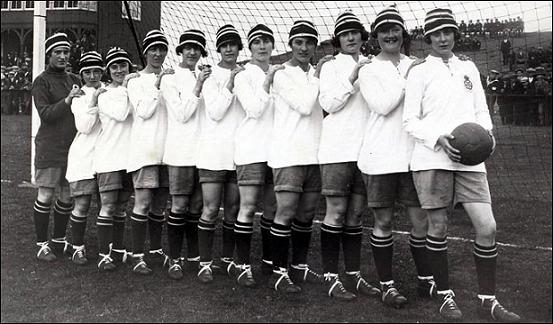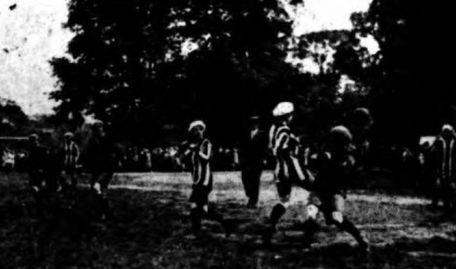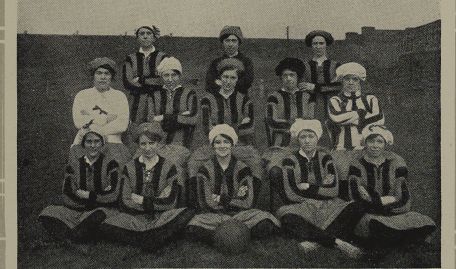Women’s Football: The Munitionettes
RSS FeedTo celebrate Lincoln City F.C’s recent successes, in 2018 The Collection was proud to put on an exhibition sharing their achievements from the past two years ('The Journey 2016-2018: An Exhibition Celebrating Two Amazing Years for Lincoln FC'). 2018 is also the year that marks the centenary of the end of World War One and the passing of the Representation of The People Act, which, for the first time in history gave some women the right to vote. A focus on football, WWI and increased attention to women’s history has led to an interest in an often glossed over area of history: women’s football and its sharp rise in popularity during World War One.
With the outbreak of the First World War in 1914, the government initially relied on voluntary recruits to serve in the British Army. It soon became clear that relying on volunteers was not enough to deal with the mounting causalities. In January 1916 the Government passed the Military Service Act which imposed conscription on all single men aged 18 – 41. The only groups that were excluded were those who were deemed medically unfit, clergymen, teachers and certain classes of industrial worker.
In the first year of conscription over one million men enlisted to fight which caused a mass labour shortage at home. Women, who for centuries had been confined to the domesticity of the home, stood up to fill the vacancies. For the first time in history women in their millions took on roles previously thought the domain of men and they proved to be highly efficient. These roles included working in factories, which were one of the biggest employers of women in the War, producing tanks, aircraft and munitions; these women were nicknamed “munitionettes.”
The factory workers began playing football in their spare time and eventually formed football teams. Although women’s football was not unheard of before the WWI it did not gain anywhere near the same popularity that the women’s football teams developed during the War. In Lincoln a variety of different teams formed including the Ruston Aircraft Girls, Lincoln Munition Girls, Foster Tank Girls and after the War the Lincolnshire Ladies. The Government encouraged women to play football as the games boosted morale and reinforced the image that women were capable of jobs deemed only appropriate for men. All of the matches women played in also raised money for War charities.
Initially women’s football teams were not taken seriously. Before the War football was seen as a predominately male sport; women’s bodies were seen as incapable of such a physically demanding game. Throughout the period ‘medical experts’ advised that football was unsuitable for women's health. The Lincolnshire Chronicle, on 9th April 1921, even reported on a 14 year old girl breaking her leg in a practice match which "lends strength to the contention in some quarters that football is a pastime unsuitable for the tender sex". Newspapers from the period seem rather patronising to modern readers often describing the matches with a great deal of hilarity. On 31st March 1917 The Lincolnshire Chronicle reported on a match between the Lincoln and Derby Munition Girls: “well, readers, to be candid, this game was very funny in many ways…most of us went to scoff (though not unkindly, I’m sure).” Despite concerns for women’s health and the matches being seen in a humorous light there was much excitement surrounding women's football.
Not all comments were unflattering. On 16th April 1917 The Lincolnshire Echo was more positive and commented that women's football seems to "be more than a passing fancy…enthusiasm around the question is very keen." It was not long before it was realised that some of the players had a natural aptitude for the game. The Lincolnshire Echo also reported on the match between the Lincoln and Derby Munition Girls, claiming that, “there were some who distinctly showed an understanding of the finer points of the game.” Like their war work, women also proved to be very capable of a sport once seen as only suitable for males.
After the War, the 1919 Restoration of Pre-War Practices Act meant that many women were forced to leave their jobs in the factories and return to their pre-war roles. Many of the football teams formed out of the munitions factories quickly disappeared. However, some women continued to play and formed local teams. In Lincolnshire a team formed called The Lincolnshire Ladies or Lincoln Ladies who played matches into 1921.
Women’s football ironically reached its peak in popularity after the War, proving to be as popular as men’s football. One game played between the Dick Kerr Ladies and St. Helens in 1920 attracted 53,000 spectators which is the biggest crowd to date for a women’s game in the UK. In France a game played by the Dick Kerr Ladies attracted a crowd larger than 63,000. However, the popularity around women’s football was not to last. Women’s football teams were soon to face scrutiny from the Football Association (FA); on 5th December 1921 the FA banned women’s football, encouraging associated clubs “to refuse the use of their grounds for such matches." They deemed “the game of football is quite unsuitable for females and ought not to be encouraged.” The ban may have had a financial as well as a sexist element as many of the ladies' games were played for charitable causes and the FA needed the revenue from the men's more commercial game.
Some teams (like the Lincolnshire Ladies) defied the FA's ban and continued to play football by using grounds unassociated with the FA like rugby grounds. A team in Lincolnshire, The Boston Ladies Club even formed after the ban and played against the Lincolnshire Ladies in 1921. Although some teams carried on playing the FA had put unavoidable barriers in front of women’s football. Women did not play professionally again until after 1971 when the ban was finally lifted.
Women's football in Lincoln has had more bad luck in recent years. In 1995, a new Lincoln Ladies team was formed, but they were moved to Nottingham in 2014 to become Notts County Ladies. Some compared this to when Wimbledon upped sticks and moved to Milton Keynes in 2003, the ladies move was less successful and Notts County Ladies folded in 2017. To this date women’s football does not draw the crowds or excitement it once did during WWI and the early 1920s, but the county is blessed with many women's teams. Sonce 2014 none of our local teams have been in the top divisions, but last year Nettleham Ladies had a good cup run and were only put out after a spirited performance by Liverpool.
This year, the Lincoln Mystery Plays Company decided to present the extraordinary story of Women’s football a century ago through the eyes of one of the most enduring of the teams from a century ago, the Lincoln Ladies.
Using plenty of humour and a real sense of spectacle, The World at Her Feet will tell the remarkable story of the Lincoln Ladies and the extraordinary challenges faced by Women and Men in the aftermath of the greatest conflict the world had ever seen.
“Who remembers a woman’s life? Who remembers a woman’s fame? Who remembers a woman’s strife? Who remembers a woman’s name?”
“I might not have much, but I’ve got my freedom and I want to play football with it.”
The play is an uplifting story of success, struggle and sacrifice and The World at Her Feet will be performed at the Drill Hall this November, but be quick, the tickets are selling fast.
[url=https://www.lincolndrillhall.com/shows/mystery-plays-the-world-at-her-feet-by-stephen-gillard/]https://www.lincolndrillhall.com/shows/mystery-plays-the-world-at-her-feet-by-stephen-gillard/[/url]
At the time of writing (November 2018) there is an interesting exhibition about the history of women's football at Lincoln Central Library.
[url=https://www.bishopg.ac.uk/bgu-launch-new-exhibition-exploring-the-history-of-womens-football/]https://www.bishopg.ac.uk/bgu-launch-new-exhibition-exploring-the-history-of-womens-football/[/url]
The three pictures are:
Top: Dick, Kerr's Ladies team from 1921 (wiki commons picture)
Top right: an unfortunately rather dark photograph of a game between the Lincolnshire Ladies and Boston Ladies 2nd July 1921 (with thanks to the British Newspaper Archive).
Bottom right: Ruston Aircraft Grils (taken from the book 'Our Part in the Great Wasr' published by Ruston and Hornsby).
By Anya Johnson.
Comments
There aren’t any comments for this blog yet



